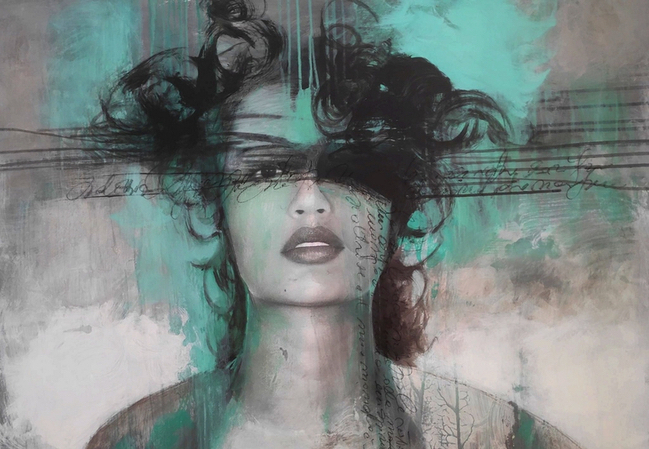La vita contemporanea tende a essere un susseguirsi di circostanze che impongono all’essere umano di nascondere se stesso e le proprie emozioni per riuscire a non soccombere, a non rivelare la propria vera essenza rischiando di essere ferito, o scoperto, o semplicemente di sentirsi vulnerabile; il compito degli artisti, attraverso la loro sensibilità, è quello di portare alla luce tutto ciò che a uno sguardo più pragmatico o realista non appare evidente, inducendo così l’osservatore a riflettere su se stesso perché guidato dal linguaggio pittorico e dalla narrazione interpretativa dell’autore di un’opera. La protagonista di oggi si avvale di una raffinata tecnica, frutto di approfondimento e fusione di altre del recente passato, per dare il suo punto di vista su tutto quel ventaglio di sentimenti che si susseguono velocemente nell’esistenza impedendo a al distratto uomo moderno di coglierne l’intensità e il senso.
Tutto ciò che aveva costituito un punto fermo, ben delimitato e circoscritto alle correnti artistiche in cui era nato, è stato destinato nel corso del Ventesimo secolo a subire trasformazioni, a fondersi con altre tecniche per dare vita a inediti linguaggi, a nuovi modi di intendere la pittura e la scultura attraverso i quali si davano le basi per ulteriori e successive interazioni e sperimentazioni; durante quel vivace secolo fu scoperto tanto, sovvertito e modificato altrettanto e gettato le fondamenta di tutta l’arte che sarebbe seguita sia alla fine del Novecento che nel nuovo Millennio. Il desiderio di mescolare tecniche originariamente appartenenti a specifici movimenti artistici si fece via via più evidente superato il primo ventennio perché già il noto Surrealismo si ispirò all’appena antecedente Dadaismo soprattutto per quella tendenza sperimentatrice che conduceva gli appartenenti al secondo a espandere la propria ricerca a campi differenti da quello strettamente artistico; questa inclinazione fu evidenziata e ampliata sia da Salvador Dalì, nelle sue divagazioni cinematografiche, sia da Man Ray con la fotografia, da Max Ernst con le innovative tecniche come il grattage, il frattage e il collage, da Meret Oppenheim con la sua capacità di trasformare oggetti di uso comune in pezzi d’arte sotto un’insolita veste. Quello che forse lasciò un’eredità particolarmente forte, dal punto di vista dell’innovazione nella tecnica pittorica fu proprio Max Ernst poiché fu esattamente al collage e al décollage che si ispirò il Nouveau Réalisme francese e anche parte della Pop Art e del New Dada. L’introduzione di manifesti pubblicitari, di parti di fotografie strappate e poi ricomposte sulla tela, spesso ritoccate con la pittura, ha contraddistinto la produzione artistica di Mimmo Rotella, tanto quanto ha costituito uno spunto per le opere dello statunitense Jasper Johns che ha saputo mescolare il collage, o forse nel suo caso sarebbe meglio definirlo assemblage, alla particolare tecnica dell’encausto. Molti anni dopo fu Gerard Richter a generare una sintesi tra tutte queste tecniche aggiungendovi la fotografia che costituiva la base su cui poi successivamente operare con la pittura introducendo elementi di disturbo per avvicinarsi all’irrealtà dell’astrazione, oppure per modificarne completamente l’essenza sovrapponendo alla base fotografica la pittura in un secondo momento grattata o frottata per allontanare lo sguardo da ogni forma conosciuta.
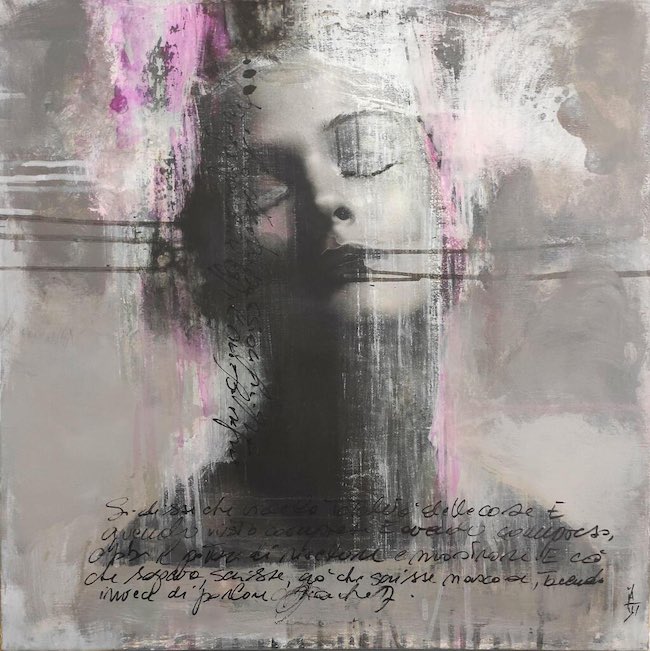
L’artista altoatesina Beatrice Mattei mescola di nuovo tutto per adeguare queste tecniche del passato alla sua naturale inclinazione, quella cioè di volgere uno sguardo sensibile ed empatico sulla realtà circostante e sui volti che abitualmente si intravedono senza osservarli con attenzione, restando così agganciata a un’immagine reale di base su cui agisce in un secondo momento sia attraverso la pittura, tendenzialmente bicromatica per lasciare che le sensazioni fuoriescano in maniera più intensa, poi parzialmente dissolta attraverso il frottage e infine inserendo parole, testi che sembrano essere interpretazione dei pensieri delle donne protagoniste dei suoi ritratti. Nel suo caso dunque ciò che viene visto nella realtà si sposta nella dimensione dell’indefinitezza, come se un approccio eccessivamente o esclusivamente estetico distraesse da quell’essenza troppo frequentemente ignorata, persa dentro un’indifferenza esistenziale che induce gli individui a osservarsi senza mai davvero conoscersi; il percorso delle sue protagoniste è di profonda introspezione che emerge dai dettagli cancellati, dalla dissolvenza dei particolari che devono essere nascosti non più per essere tutelati dall’esterno bensì per porsi in posizione di più attento ascolto di sé.
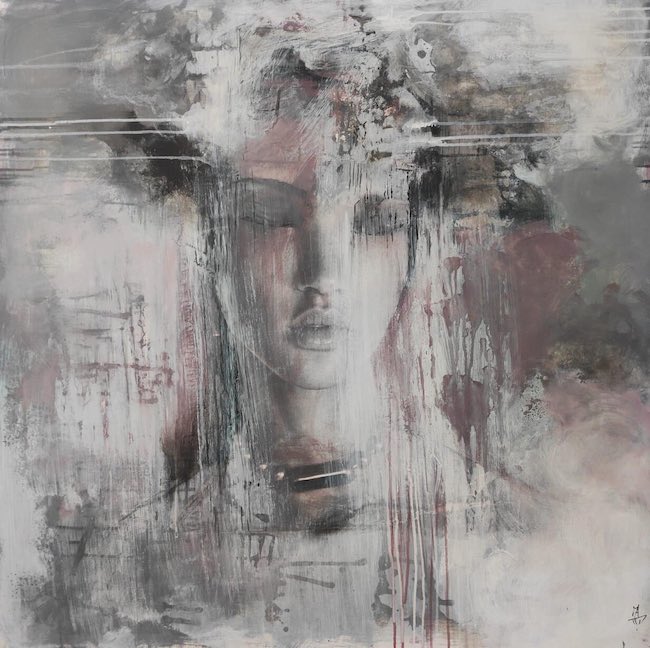
Il dialogo interiore che le donne compiono emerge invece dalle parole che Beatrice Mattei appone sulla tela, come se costituissero un percorso scolpito nel tempo, un diario di quel frangente emozionale durante il quale hanno potuto prendere atto degli accadimenti, del proprio sentire e di tutto ciò che da un singolo istante è poi scaturito; il frangente immortalato dall’artista è esattamente quello della presa di coscienza, del lasciar affiorare i ricordi, le meditazioni che si manifestano poi attraverso quell’eco suggestiva impressa nelle parole e accresciuta dalla dissoluzione dei dettagli.
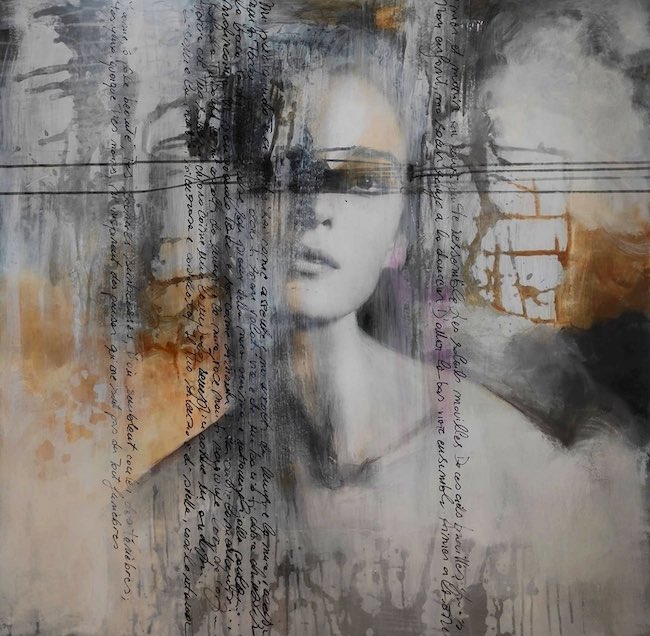
Questo è ciò che emerge in maniera particolarmente forte ed evidente nell’opera Momenti privati in cui una parte dello sguardo della ragazza è completamente cancellato, oscurato dalla necessità di andare a fondo agli accadimenti, di scolpire nella propria anima l’alternarsi di tutto ciò che ha generato il presente, che sia stato un incontro, una scelta, un’opportunità persa oppure colta, poco importa, ciò che conta davvero, sembra suggerire Beatrice Mattei, è la capacità di analizzare gli eventi e custodirli gelosamente all’interno di sé come parte del proprio percorso evolutivo. La scala di grigi in questa tela è interrotta dal giallo ocra, a sottolineare il bisogno di concretezza in virtù della quale è possibile porsi in contatto con il proprio lato più consapevole, più in grado di analizzare l’accaduto.
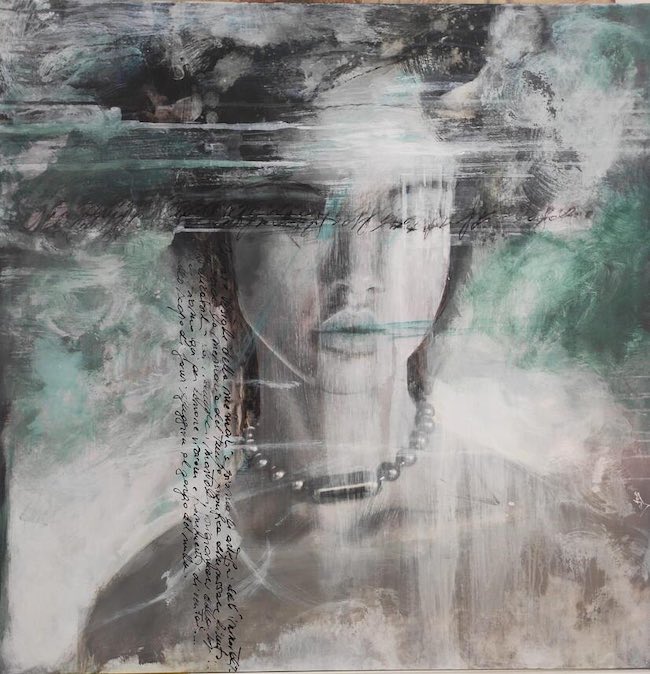
Di contro invece in Memorie sommerse la tonalità dominante con cui la Mattei interrompe la bicromia del bianco e nero è il verde chiaro, come se volesse sottolineare il bisogno di innalzarsi dalla contingenza e porsi in contatto la parte naturale di sé, iniziando un percorso di esplorazione di tutto ciò che sembra essere stato dimenticato ma in realtà pronto a fuoriuscire perché di fatto solo nascosto in un angolo remoto dell’interiorità. Attraverso il processo di astrazione dalla realtà quotidiana, quello evocato dall’artista attraverso le palpebre chiuse della giovane protagonista della tela, è possibile ritrovare il contatto perduto a causa della necessità di andare oltre e proiettarsi verso il futuro; ma di fatto non esiste futuro se si perde la connessione con il passato, questo sia dal punto di vista storico che da quello personale, perché è solo conoscendo ed esplorando tutti gli aspetti di come si è stati e come si è diventati a seguito di quei dettagli che hanno inaspettatamente generato il cambiamento, che è possibile diventare più forti.
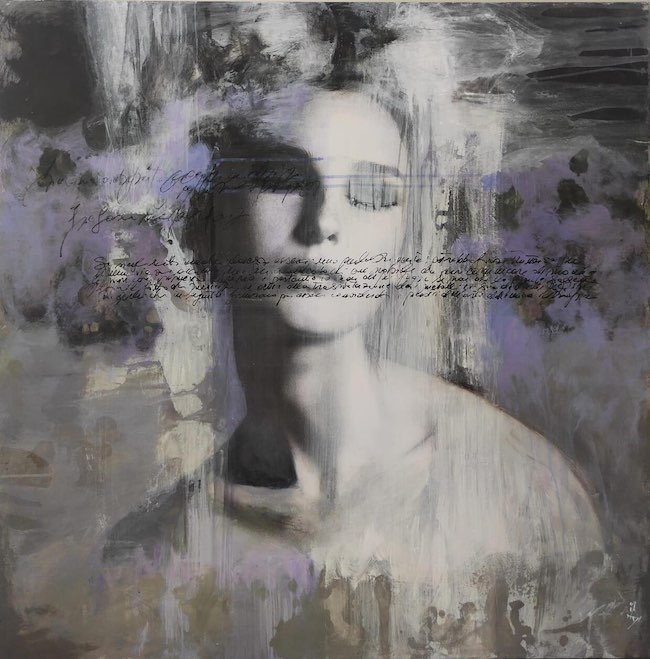
Anche in Anteprima di un sogno gli occhi della donna sono chiusi, trasportati in quel mondo onirico di cui tanto hanno parlato gli artisti del passato, che però in questo caso abbandona le inquietudini e le angosce del Surrealismo per entrare in una dimensione magica, idilliaca, in cui perdersi e lasciarsi semplicemente trasportare da tutte le emozioni, costituite dalle sfumature di viola, che avvolgono il volto della ragazza; in quest’opera le parole sembrano correre velocemente, come se la mente non fosse in grado di correre alla velocità del sogno, di un’immaginazione necessitante di lasciarsi andare senza i filtri della ragione.
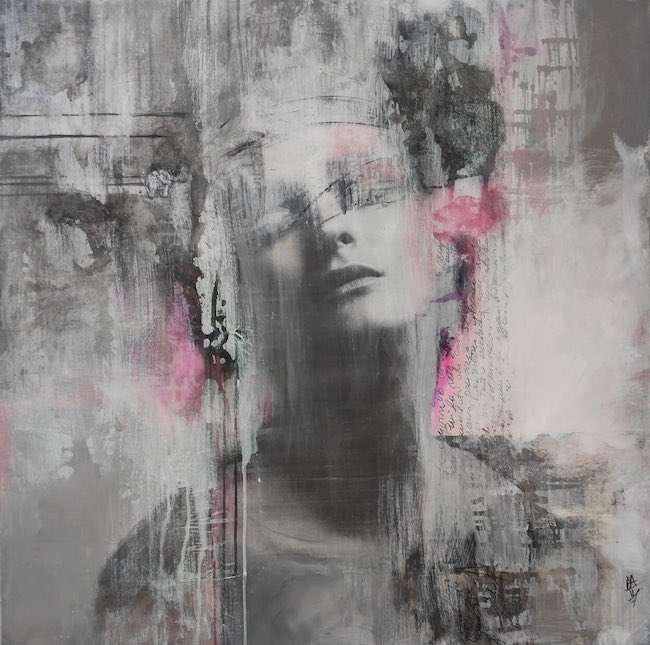
Le pose delle donne immortalate dall’artista sono quelle dei ritratti dell’impressionista italiano Giovanni Boldini, eleganti, raffinate ma soprattutto delicate ed eteree, quasi come se per Beatrice Mattei fosse importante sottolineare l’essenza morbida di un genere femminile che malgrado la necessità di doversi adeguare ai cambiamenti dei tempi, ha bisogno di non perdere il contatto con quel lato interiore puro, nascosto per timore che venga ferito.
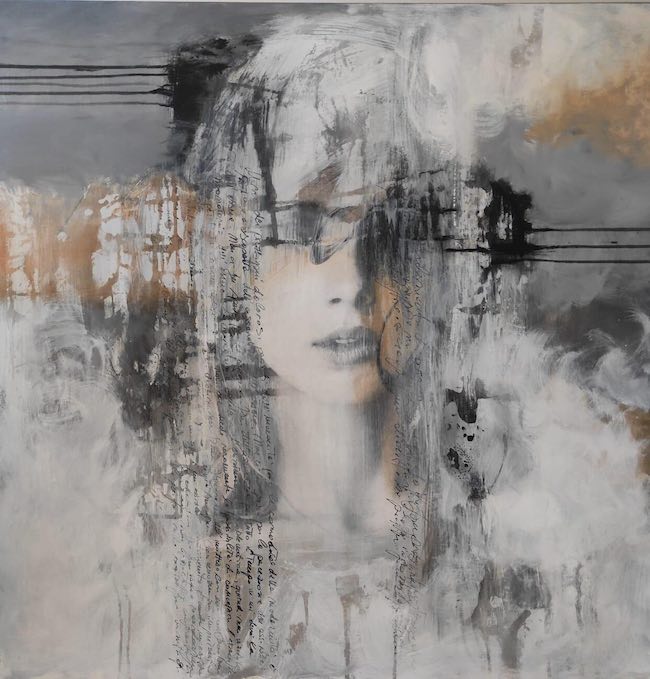
Di fatto il suo è un Espressionismo contemporaneo, dove il colore, ma anche l’azione che l’artista compie sull’opera, si armonizzano con il frammento di emozione che desidera sia protagonista della tela. Beatrice Mattei inizia la sua carriera artistica ed espositiva nel 1989 e attualmente ha al suo attivo molte mostre personali e la partecipazione a concorsi nazionali e internazionali dove ha ottenuto vari premi e riconoscimenti. Ha esposto in varie città italiane, fra cui Trento, Verona, Udine, Venezia, Bolzano, Perugia e all’estero, Innsbruck, Lussemburgo e Atene.
BEATRICE MATTEI-CONTATTI
Email: beatrice.mattei6@gmail.com
Sito web: https://www.fida-trento.com/beatrice-mattei
https://www.associazione-artisti.com
The scratched details of Beatrice Mattei’s portraits, between whispered words and feelings revealed by indefiniteness
Contemporary life tends to be a succession of circumstances that force human beings to hide themselves and their emotions in order not to succumb, not to reveal their true essence by risking being wounded, or discovered, or simply feeling vulnerable; the task of artists, through their sensitivity, is to bring to light everything that to a more pragmatic or realist gaze does not appear obvious, thus inducing the observer to reflect on himself because he is guided by the pictorial language and interpretive narrative of the author of an artwork. Today’s protagonist makes use of a refined technique, the result of deepening and fusing others from the recent past, to give her point of view on the whole range of feelings that quickly follow one another in existence, preventing the distracted modern man from grasping their intensity and meaning.
Everything that had constituted a fixed point, well delimited and circumscribed to the artistic currents in which it was born, was destined during the course of the twentieth century to undergo transformations, to merge with other techniques to give rise to new languages, to new ways of intending painting and sculpture through which the foundations were given for further and subsequent interactions and experimentation; during that lively century so much was discovered, subverted and modified just as much and laid the foundations of all the art that would follow both at the end of the twentieth century and in the new Millennium. The desire to mix techniques originally belonging to specific artistic movements gradually became more evident beyond the first two decades because already the well-known Surrealism was inspired by the just preceding Dadaism mainly by that experimental tendency that led those belonging to the latter to expand their research to fields other than the strictly artistic; this inclination was highlighted and expanded both by Salvador Dali in his cinematic digressions and by Man Ray with photography, by Max Ernst with innovative techniques such as grattage, frattage and collage, by Meret Oppenheim with her ability to transform everyday objects into pieces of art in an unusual guise. The one who perhaps left a particularly strong legacy from the point of view of innovation in painting technique was Max Ernst since it was exactly from collage and décollage that French Nouveau Réalisme and also part of Pop Art and New Dada were inspired.
The introduction of advertising posters, of parts of photographs torn and then reassembled on canvas, often retouched with paint, distinguished the artistic production of Mimmo Rotella, as much as it constituted a cue for the artworks of the American Jasper Johns who knew how to mix collage, or perhaps in his case it would be better to call it assemblage, with the particular technique of encaustic. Many years later it was Gerard Richter who generated a synthesis of all these techniques by adding photography, which constituted the base on which he then subsequently worked with painting by introducing disturbing elements to approach the unreality of abstraction, or to completely modify its essence by superimposing on the photographic base painting at a later time scratched or frosted to draw the eye away from any known form. The South Tyrolean artist Beatrice Mattei mixes it all again to adapt these techniques of the past to her natural inclination, that is, to turn a sensitive and empathetic gaze on the surrounding reality and faces that one habitually glimpses without observing them carefully, thus remaining hooked to a basic real image on which she later acts both through painting, that tends to be bichromatic in order to let the sensations escape more intensely, then partially dissolved through frottage, and finally by inserting words, texts that seem to be interpretations of the thoughts of the women protagonists of her portraits. In her case, therefore, what is seen in reality shifts into the dimension of indefiniteness, as if an excessively or exclusively aesthetic approach distracts from that essence too frequently ignored, lost within an existential indifference that induces individuals to observe themselves without ever really knowing themselves; the path of her protagonists is one of profound introspection that emerges from the erased details, from the fading of particulars that must be hidden no longer to be protected from the outside but to place themselves in a position of more attentive listening to themselves.
Instead, the inner dialogue that the women carry out emerges from the words that Beatrice Mattei affixes to the canvas, as if they constituted a path carved in time, a diary of that emotional juncture during which they were able to take note of the events, of their own feeling and of everything that then arose from a single instant; the juncture immortalized by the artist is exactly that of the coming to consciousness, of letting memories surface, meditations that are then manifested through that evocative echo impressed in the words and increased by the dissolution of the details.. This is what emerges in a particularly strong and evident way in the artwork Private Moments in which a part of the girl’s gaze is completely obliterated, obscured by the need to get to the bottom of the events, to carve in one’s soul the alternation of everything that generated the present, whether it was an encounter, a choice, an opportunity lost or taken, it matters little, what really matters, Beatrice Mattei seems to suggest, is the ability to analyze the events and jealously guard them within oneself as part of one’s evolutionary path. The scale of grays in this canvas is interrupted by yellow ochre, underscoring the need for concreteness by virtue of which it is possible to get in touch with one’s more conscious side, more able to analyze what happened. In contrast, on the other hand, in Submerged memories the dominant shade with which Mattei interrupts the bichromy of black and white is light green, as if she wanted to emphasize the need to rise from contingency and get in touch with the natural part of oneself, beginning a path of exploration of all that seems to have been forgotten but actually ready to escape because in fact only hidden in a remote corner of interiority. Through the process of abstraction from everyday reality, the one evoked by the artist through the closed eyelids of the young protagonist of the canvas, it is possible to regain the contact lost because of the need to go beyond and project into the future; but in fact there is no future if one loses the connection with the past, this from both the historical and personal points of view, because it is only by knowing and exploring all aspects of how one has been and how one has become as a result of those details that unexpectedly generated change, that it is possible to become stronger.
In Preview of a Dream, too, the woman’s eyes are closed, transported into that dream world of which the artists of the past have spoken so much, but in this case it abandons the restlessness and anxieties of Surrealism and enters a magical, idyllic dimension in which to lose oneself and simply be transported by all the emotions, constituted by the shades of purple, that envelop the girl’s face; in this artwork the words seem to run fast, as if the mind were unable to go at the speed of the dream, of an imagination needing to surrender without the filters of reason. The poses of the women immortalized by the artist are those of the portraits of the Italian Impressionist Giovanni Boldini, elegant, refined but above all delicate and ethereal, almost as if for Beatrice Mattei it was important to emphasize the soft essence of a female gender that despite the need to have to adapt to the changes of the times, needs not to lose touch with that pure inner side, hidden for fear that it will be hurt. In fact, hers is a contemporary Expressionism, where color, but also the action that the artist performs on the artwork, harmonize with the fragment of emotion that she wants to be the protagonist of the canvas. Beatrice Mattei began her artistic and exhibition career in 1989 and currently has to her credit many solo exhibitions and participation in national and international competitions where she has won various prizes and awards. She has exhibited in various Italian cities, including Trento, Verona, Udine, Venice, Bolzano, Perugia and abroad, Innsbruck, Luxembourg and Athens.


